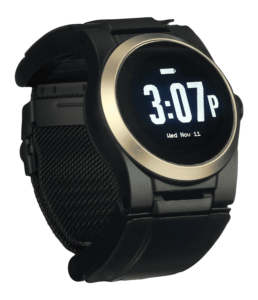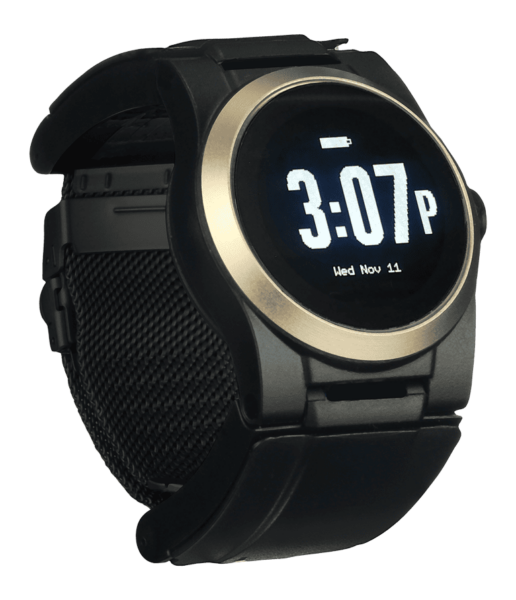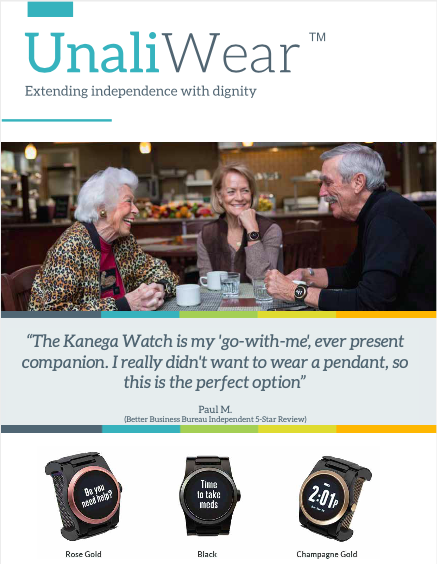There's nothing like a Kanega Watch
There’s nothing like a Kanega Watch anywhere in the world – except here in the USA. Get rid of those old stereotypes, and let our frequently asked questions guide you in the exploration of a new world of independence with dignity for vulnerable populations.

| Watch face diameter | Watch face thickness | Watch weight |
| 1.6 inches | .5 inches | 49 grams |
Frequently Asked Questions (FAQs)
About the Kanega Watch
We know who you are and can find you in an emergency.
In an emergency situation, the cell phone requires the user to initiate the call, which may be difficult or impossible in a medical emergency. The 911 operator will have no information about the caller, their location, or emergency contact information. Even if the caller can communicate, valuable time can be wasted while the 911 operator gathers needed information.
In contrast, the Kanega Watch can detect a fall and automatically connect the wearer to the monitoring center. The wearer can also initiate a call to the monitoring center with a button press or a spoken command. Whether initiated automatically by the watch or by the wearer, the Kanega Watch connects to an operator who has the wearer’s contact information and location at hand, and if needed, can quickly summon help.
Finally, the Kanega Watch’s unique batteries-in-the-band solution allows the Kanega Watch to be worn 24/7 without having to take it off to charge. Many people charge their cell phones at night and do not take their phone with them to the bathroom where many falls occur.
While some smart watches have safety features such as fall detection, the watches must be removed to charge. Most people charge their watches at night, when many falls happen. A trip to the bathroom with the smart watch on the charger provides no protection.
The Kanega watch has a patented quick-swap battery system, which means you never have to take it off to charge.
Actually, it can be much more efficient, for a number of reasons:
- The time to speak to our monitoring service agent through your watch can frequently be faster than connecting to 911.
- The monitoring agent can handle both major (“send EMS”) and minor (“call my neighbor and have them help me”) emergencies that you may communicate.
- In the event that an alert gets sent from the watch and you are not responsive:
- Your GPS location should be readily available to the monitoring agent. That is not always the case with 911.
- The agent can contact your emergency contacts can do a wellness check to see if the Kanega Watch wearer is OK. 911 will not do that.
- The agent can dispatch EMS directly, as 911 can, but the agent can also provide the EMS dispatch with the wearer’s medical info (health status, medication allergies, etc.) as well as lockbox/spare key info if that is in the wearer’s profile provided during watch set-up.
- 911 may not dispatch if they get no response from the caller, due to the overwhelming number of false alerts flooding 911 these days from the Apple Watch and related devices. Here is a recent article which describes this phenomenon.
- With the Kanega Watch, you have 3 ways to get help in an emergency–button, voice and fall detection. All these alerts go to our US-based 24/7 monitoring center. The agent who receives that alert will try and speak to the wearer through the watch. The agent will say “Hi, this is X from UnaliWear, do you need help?”
- If the wearer is responsive, the wearer can speak to the agent and direct whatever care is needed; from “call my neighbor to help me off the floor” to “call EMS, Police or Fire” or even “call my daughter and have her come over to get the blankets from the top of the closet” (this really happened). The agent does what the wearer asks.
- If the wearer is not responsive, the agent will call the wearer’s phone number and, if there is no response, immediately call the first listed emergency contact (as listed in the wearer’s profile) – we recommend that is someone who lives nearby. The agent will say “Hi this is X from UnaliWear. We just received an alert from (wearer) and (wearer) is not responding. Are you able to check on (wearer)?” Note: It’s not infrequent where the emergency contact is in the same house as the wearer and didn’t know the wearer had fallen in the garage.
- If the answer is no or if no emergency contacts answer the call, the agent will dispatch local emergency services to the wearer’s location. The agent has the same access to EMS as 911 does, so it is not an extra call to 911, so it saves a step. In addition, the agent can also provide EMS with the wearer’s medical info—such as medicine allergies, health conditions, etc.; and, if the wearer is home, can even provide spare key location or lock box info, so EMS does not have to break down the door. This ensures the EMS response can be faster and more informed than a generic 911 dispatch.
- If EMS is dispatched, the agent will inform all the emergency contacts via phone of what has taken place. Note that our monitoring center agents call from the same phone number, so the wearer and all emergency contacts can add this number to their phone contact list, so they know it is not spam.
That statement is false. It is hard to understand how they can make that claim when Apple and Samsung (as well as the Kanega Watch) have fall detection wrist-based technology. In addition, the NY Times/Wirecutter awarded UnaliWear’s Kanega Watch the “Best On-The-Go Medical Alert Device” partly because of the flawless fall detection testing. Simply, this is an engineering problem that was solved about 5 years ago that companies in the business of primarily selling fall detection neck pendants simply want to ignore. In addition, the Kanega Watch is the only fall detection offering of any kind with RealFall™ fall detection technology. Click here to learn more about RealFall™ and how it is truly a revolutionary change in the fall detection accuracy.
The Kanega Watch provides fall detection, emergency response, and medication reminders in a stylish watch design—avoiding the perceived stigma of traditional emergency buttons and pendants.
No, you do not need a phone. The Kanega Watch is a standalone device with built-in Wi-Fi and LTE technologies.
We would ask why other medical alert companies don’t offer Wi-Fi connectivity for their devices in their wearers’ homes. We think it is a critical feature, as many people have weak or inconsistent cell service in their homes (particularly in interior bathrooms with load bearing walls that can block cell service). That is not a good match for any medical alert system that is supposed to keep you connected 24/7 for emergency response. The Kanega Watch’s cell service runs exclusively on the Verizon 4G/5G Network, and the watch can also connect to pretty much any home Wi-Fi system from any provider. We think this offers the most reliable connectivity system in one’s home‑where many accidents tend to occur.
Correct. The watch will still likely work in a wearer’s home, through Verizon cellular, but the quality of the cell signal will most likely not be as consistent or strong as Wi-Fi throughout the home. Please consider getting home Wi-Fi from your cable or related provider. The cost is generally a fraction of that for a medical alert system and it ensures consistent communication reliability, which could be critical in your time of need.
The Kanega Watch comes with two all-inclusive Plan options. There are no additional fees, taxes, or surprise charges:
Annual Plan – Save Nearly 20% Over Monthly Plan
Your Kanega Watch/All Accessories + Full Set-Up: $299
Annual Service Subscription: $779.40
Monthly Plan
Your Kanega Watch/All Accessories + Full Set-Up: $299
Monthly Service Subscription: $79.95
Both plans come with a 30-day money-back guarantee return policy. For the Annual Plan, returns after 30 days will be issued a pro-rated refund for all unused months remaining in subscription year. With either plan, there is no contract to sign, and you are free to cancel at any time.
We offer a discounted rate for 2 people getting Kanega Watches in the same physical location (our Family Plan), as well as a free month of service for families of active-duty military and veterans as well as AARP members. Call us at +1-888-343-1513 for details.
Unfortunately, Medicare and other forms of traditional insurance do not cover medical alert systems (though some Medicare Advantage Plans do, they do not cover the Kanega Watch at this time). Some health insurance plans that include Health or Flexible Savings Accounts allow you to apply your savings to medical alert systems, including the Kanega Watch (you should check with your health insurance regarding this option). Finally, some long-term care insurance plans also cover medical alert systems, including the Kanega Watch.
UnaliWear collects data for the monitoring service and to maintain the functionality of the Kanega Watch. The watch has built-in sensors to gather information about location, movement/falls, humidity, battery status, and connectivity. Data is also collected from the use of voice commands to interact with the watch and calls to the emergency monitoring service.
The Kanega Watch extends your independence. Wi-Fi and LTE wireless technologies allow the Kanega Watch to go everywhere you go.
The Kanega LTE watch has been tested to an IP67 Waterproof Rating to provide protection against running water. You can wear your watch while exercising, washing your hands, and in the shower, but immersive activities such as swimming, water aerobics and bathing will likely irreparably damage the watch, requiring a replacement that is NOT covered by our consumer warranty.
Yes. The Kanega Watch can remind you when it is time take your medications.
Yes. The Kanega watch will not interact negatively with a pacemaker or an Implantable Cardioverter Defibrillator (ICD).
Unlike many alternative options, the Kanega Watch contains no magnets that might interfere with a pacemaker/ICD performance. For all watches shipping as of October 28, 2024, the band on the Kanega Watch does contain a magnetic clasp. However, we do have a non-magnetic clasp option. If you would like that option instead of our standard band, simply call us to place your order (888-343-1513) and we can ensure you get a watch with a non-magnetic clasp band.
Traveling or Moving Around
No. The Kanega Watch monitoring service includes cellular connectivity. Wi-Fi in the home is required to augment internet connectivity.
Absolutely. The Kanega Watch has its own Verizon cell data plan that is part of your watch service (included as part of both our Annual and Monthly Plan options). Your watch does not have to pair with any other device to work—not a cellphone, base station, pendant, etc. Regarding your home Wi-Fi, the watch can connect through any provider of Wi-Fi service – whether that is Verizon, or another provider does not matter. The watch can even connect through permanent Wi-Fi hot spots, like MiFi.
GPS is a US government-controlled satellite system. When an alert gets activated on a Kanega Watch, the watch’s antenna seeks to connect to this system to identify the wearer’s location to the monitoring service agent who receives the watch’s alert. GPS is a great service but is not 100% reliable. This is particularly true inside buildings/homes where the satellite signal may be hard to reach. This is why UnaliWear requires our wearers to have and provide us with their home WiFi credentials – allowing us to configure the watch to further establish their location (and communicate more effectively) through WiFi where inside accidents are most likely to occur – in people’s homes. Note the Kanega Watch can be configured to identify and connect through up to seven different WiFi locations – providing our wearers with multiple opportunities to benefit from WiFi connectivity (e.g.: another family home, an office, a neighbor, etc.). It is unlikely but possible that the agent may not receive a wearer’s location when an alert is activated; and may ask the wearer for their location. If the wearer is unresponsive via the watch or primary phone number, and the agent is unable to reach any of the wearer’s emergency contacts, the agent will send emergency services to the wearer’s home address – as a “better safe than sorry” protocol.
Yes and No. The Kanega Watch is not a tracking device. It currently does not have an accompanying app for a smart phone for another person to track a wearer. The Kanega Watch does provide a location when an alert is sent from the watch to our monitoring center. In addition, the watch checks in with its location approximately every hour.
No. The Kanega Watch is currently configured to use only the cellular network in the United States.
Using the Kanega Watch
Very easy. It is quick and simple to swap the batteries in the watch band for the batteries in the charger. The batteries are about 1 inch square, so they are designed for people with limited dexterity. While we have many wearers in their 60s and 70s (and even younger), our oldest wearer is currently 103, and she has been changing her batteries regularly for years with no issues.
Yes. It is a quick swap every 24-36 hours. We recommend you change them proactively as a habit (like when you are brushing your teeth at night). The battery changing process was specifically designed to be easy for everyone, even those people with more limited dexterity. As an aside, our oldest Kanega Watch wearer is currently 103 and she has been regularly swapping out her depleted batteries on the watch for the fresh set of batteries sitting in her charger for nearly 3 years now with no issues.
Best practice is to proactively change batteries daily; every 24-36 hours. We recommend our wearers to make it part of their morning or evening routine, like they do brushing their teeth.
It is not a dainty watch, for sure. The actual watch face is about the size of an Apple Watch. The size difference really comes from the watch band, which is about an inch across, to accommodate the rechargeable batteries. Note it is not a heavy watch—it weighs about the same as two slices of bread. Our wearers prefer a slightly thicker band to a neck pendant or another option which must be taken off regularly to charge (which they may not put back on).
In addition, once you order the watch, we will collect the wearer’s specific wrist size measurements, to attach the correct sized back band of the watch to match the wearer (the back band comes in S, M, L and XL and can fit wrists as small as 5 inches in circumference).
Purchasing the Kanega Watch Services
While our offering can be a bit more expensive than other all-in-one medical alert wearables, those offerings rely on older pendant-based technology that can be very clunky and stigmatizing to wear around your neck (or can be worn on the wrist but doesn’t include fall detection). Note also that traditional medical alert devices are only worn about 30% of the time; and rarely at night when people can be most vulnerable. Alternatively, close to 90% of Kanega Watch wearers wear it round the clock. Thus, our wearers are getting much more protection and value from their Kanega Watch than the medical alert alternatives. We also provide discounts to AARP members, members of retired military families, as well as for couples wishing to both get Kanega Watches. Please ask us about those opportunities if you would like to learn more.
In addition, the Kanega Watch is the only device on the market with RealFall™fall detection technology. Based on real falls by real people (other fall detection technology is actually based on fake or predictive falls) and gets smarter over time.
Finally, when you are comparing prices of all-in-one medical alert devices, make sure you are doing an apples-to-apples comparison. Pricing plans for the Kanega Watch are all inclusive. Other companies charge more for fall detection (if they even offer it), a cellular data plan, tax, shipping, etc.
Yes. Both plans are all-inclusive. In addition, whenever you cancel your service after your initial 30-day trial period (if purchased after 5/13/24), we will send you a return shipping label to return your equipment for a partial equipment refund (based upon the condition of the equipment upon return).
Both plans come with a 30-day money back guarantee, starting from the date of shipment to the date of return. Simply return the equipment back to us in good condition and we’ll refund your entire purchase price; less a $75 restocking fee (which includes a free return shipping label). Please note that if you choose to pay for faster shipping to receive your Kanega Watch vs. our standard free FedEx Ground, that upgraded shipping charge is not refundable.
In addition, while the watch works out-of-the-box with no set up required on your part, we have a personal on-boarding call with each new wearer to answer any questions and make whatever adjustments to the watch the wearer would like (such as increasing or decreasing the sensitivity of the fall detection and voice activation alerts) to ensure the watch fits each wearer’s particular needs and lifestyle.
The Kanega Watch comes with a Lifetime Warranty for manufacturing defects and performance issues. If this happens, we will provide a free replacement (not including shipping).
It is rare for a wearer to break a Kanega Watch. If it happens, we provide a free replacement the first time (not including shipping). For future breaks, replacement cost is $199 + shipping, but these happen very rarely. The Kanega Watch is designed to be worn for many years.
360 VIEW
Click and drag on image to spin

Meet the
Kanega Watch
(learn more)


